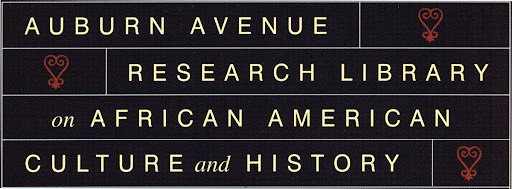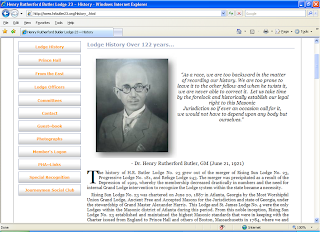Thursday, March 24, 2011
Archives and Publics: Dynamic Women = Relevant & Engaged Work
For visitors just finding the blog or regulars who may have forgotten, the Archives and Publics series is about connections between archives and various publics – scholars, interns, genealogists, students, documentary filmmakers, authors, artists, and others. The series highlights the ways in which different groups access and use archives with a focus on AARL's constituents. Today, we have two features about faculty and graduate students from the University of Georgia and the University of West Georgia -- all dynamic women doing relevant and engaged work related to African American culture and history. Another connection is that they've all conducted research in AARL's Archives Division.
In the past, we've included posts (here and here) from graduate students in the Public History program in the History Department at the University of West Georgia. Today, our first feature is UWG’s Dusty Marie Dye, who over a year ago visited AARL regarding a public history project about African American burial sites in Atlanta’s Oakland Cemetery. In February of this year, her contributions to the project came to fruition when the Historic Oakland Foundation launched “African American Voices,” a cell phone walking tour and outdoor exhibition that interprets the cemetery's African American history; see the image above. You can read more about it here, and in the Spring 2011 issue of the Oakland Herald. See also UWG's Center for Public History's project on African American shape note singing, which Dye served on as a graduate research assistant.
Next is an update on UGA's Dr. Barbara McCaskill, Christina L. Davis, and JoyEllen Freeman's research project about the life and work of Joseph Richardson Jones. For months we've chronicled their work here, here, here and here. Below is an e-mail from McCaskill about a recent visit to Jacksonville, Florida, where Jones was born. It's amazing to see how their research evolves, where some details about Jones's life remain elusive, while others surface through meticulous and thorough investigation.
A short two days later, McCaskill shared articles featuring separate (and fantastic) research projects conducted by Davis and Freeman. To read about Davis's collabortive work with Dr. Ron Butchart on Reconstruction-era teachers, follow this link. For information about Freeman's research about nineteenth century African American pianist Thomas Bethune or "Blind Tom," visit here.
Research databases, articles and encyclopedia entries, community programs, oral histories, audio walking tours -- these diverse projects reach a variety of publics in meaningful ways. They also demonstrate how archives live outside of little (sometimes large) gray boxes.
We look forward to sharing more from our colleagues and constituents.
Posted by Wesley Chenault, Library Research Associate
Labels:
Archives and Publics,
public history,
public humanities,
research,
University of West Georgia
Wednesday, March 16, 2011
One Woman's Dream: The Unfolding Legacy of Evelyn J. Frazier
Just in time for Women's History Month, here is a peek at One Woman's Dream: The Unfolding Legacy of Evelyn J. Frazier, an exhibition about the business, civic, educational, and political life of an incredibly dynamic individual. From now until Sunday, May 29, 2011, the exhibit is open in the small gallery on the first floor at AARL. Curators Pennye Hicks (Frazier's niece) and Kenneth Green of Spelman College did a wonderful job of converting 200 square feet into an eye-catching, interactive user experience.
Tall panels flank the left and center walls of the space, providing viewers with biographical information, historical context, and a timeline of important dates and events related to Frazier's life, and with a subtle cue about the exhibit's left-to-right flow. "Evelyn's Journey," the tallest panel, contains a video component installed midway through the timeline. Using the headphones provided, viewers encounter a visual and audio narration of Frazier's personal and professional development.
Anchoring the center wall is a panel titled, "The Two Steeples," which includes information about Frazier's activities in the historic Big Bethel A.M.E. Church and Morris Brown College. Mounted to the wall to the right of "The Two Steeples" are a series of black hinged boxes. The face of each is covered with a reproduction photograph or document. Upon opening a box, viewers read details and descriptions about the exterior image. It’s a clever way to add depth to two-dimensional objects and to engage viewers physically.
Anchoring the right is the show-stopper, a small reproduction of the interior of Frazier's Cafe Society, a popular African American eatery, complete with booth, counter, and framed original ephemera -- a menu, matches, napkins, full page ad -- and much more. It's a visual treat.
Posted by Wesley Chenault, Library Research Associate
Labels:
archives,
exhibitions,
memory,
race relations,
research,
segregation,
women's history
Wednesday, March 9, 2011
Open for Research: Andrew J. Young Papers + Jean Childs Young Papers
On Sunday, March 06, the Auburn Avenue Research Library celebrated the opening of the Andrew J. Young Papers, as well as those of his first wife Jean Childs Young. Close to 400 people attended the event, which included a conversation between Ambassador Andrew Young and the Honorable Kasim Reed, Mayor of the City of Atlanta, a display of rare and unique items from the collection, and a catered reception. It also received widespread media coverage. You can view the event here, listen to a report here, and read about it here, here, here, and here.
AARL's Adiministrator Francine Henderson, Archivist Kerrie Cotten Williams, and Project Archivist Cheryl Oestreicher were part of the program. Each spoke eloquently about the importance of public libraries, research libraries, and archives. For Oestreicher, it was an occassion to highlight the experience of working closely with Young's papers. You can read her address below.
Comments for Andrew Young Event - .
If you are interested in perusing the finding aids, visit our online finding aids here.
Next up for Oestreicher and team is the Atlanta Chapter of the NAACP records. Stay tuned.
Posted by Wesley Chenault, Library Research Associate
Friday, March 4, 2011
Research 2.0: Henry Rutherford Butler + Internet + Internet Archive
Archives and technology. It’s difficult to summarize in a post how technology has and continues to radically change research. Suffice it to say we have taken the digital turn, an exhilarating if not dizzying shift. This is a case in point.
Recently Nicole Carmolingo, a former AARL intern, wrote an entry about Henry Rutherford Butler for publication in the New Georgia Encyclopedia. Butler, one of the first African American physicians to establish a practice in Atlanta, lived from 1862 to 1931. While this date range is significant in terms of United States and African American history, one way to view Butler’s life span is through the lens of copyright law. Most of the written traces that document his education, career, and fraternal affiliations are in the public domain, that legal space where technology giants like Google Books thrive, and repositories, including AARL, turn for digitization projects, see here. (Note: AARL holds the Selena Sloan Butler family papers, which include materials related to her husband Henry Rutherford Butler and son Henry Rutherford Butler Jr.)
In addition to traditional research methods, Carmolingo surfed the internet to gather a great deal of biographical information using published secondary sources that are now online. Examples include Daniel Wallace Culp’s Twentieth Century Negro Literature (Or a Cyclopedia of Thought on the Vital Topics Relating to the American Negro, by One Hundred of America's Greatest Negroes), published in 1902, and Edward. R. Carter’s The Black Side: A Partial History of the Business, Religious, and Educational Side of the Negro in Atlanta, Ga. from 1894. My fact checking of her entry, part of the editorial process, also was aided by Google Books and online repositories, such as the Internet Archive. (I credit the Atlanta History Center’s now-defunct blog, Pardon Our Backlog, for the tip.)
In one instance, I needed to verify the name of Butler and colleague Dr. Thomas Heathe Slater’s business, Butler, Slater & Co – the first drug store licensed by the state that was owned by and operated for African Americans. As many researchers know, the Atlanta City Directory, accessible in print form and microfilm, is a go-to resource for information about the city’s people and places. The big news, however, is that some are now digitized; sample a virtual copy of the 1878 volume here. What would have taken a visit to another repository and an hour or more of research to fact check one company name turned into a few minutes of sitting and clicking, thanks to the Internet Archive.
Of course, not everything is or will be digitized. Today’s researchers must balance traditional and contemporary practices to yield the best results. But at this moment in time – when each day holds new online discoveries – technology-enabled changes that facilitate access to the records of our collective past are still something to marvel.
Posted by Wesley Chenault, Library Research Associate
Labels:
archives,
Atlanta History Center,
grants,
Henry Rutherford Butler Sr,
National Historical Publications and Records Commission,
New Georgia Encyclopedia,
research,
Research 2.0,
Selena Sloan Butler
Subscribe to:
Posts (Atom)








